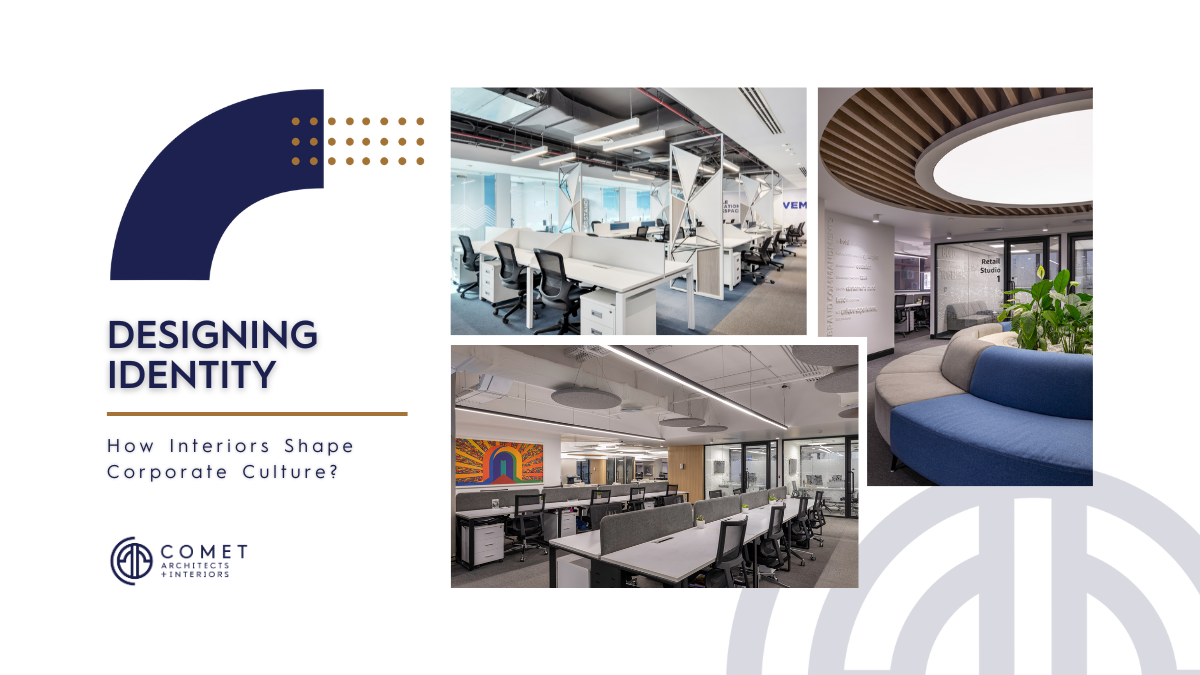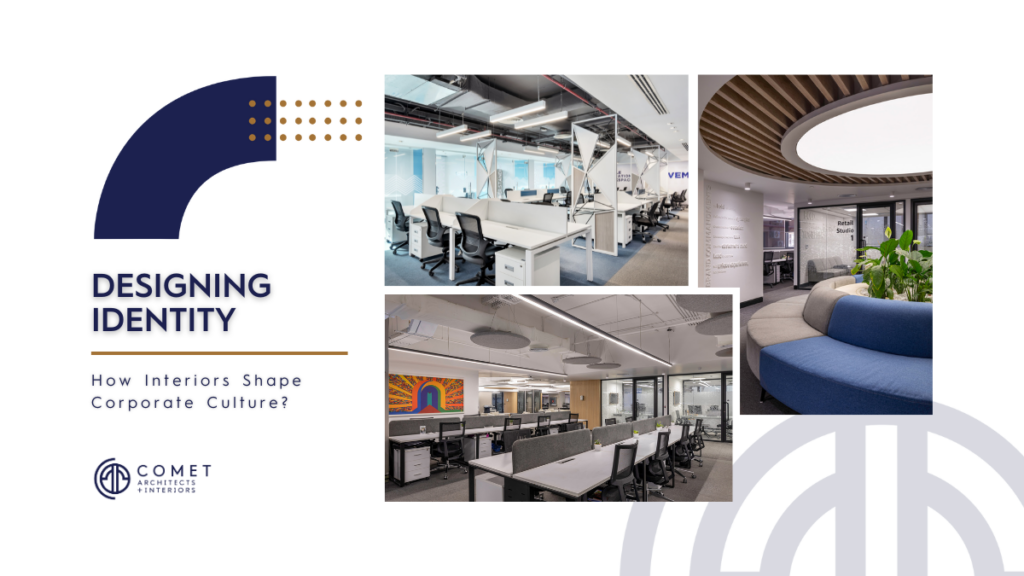
Designing Identity: How Interiors Shape Corporate Culture

Designing Identity: How Interiors Shape Corporate Culture
In today’s fast-paced corporate world, the essence of a company extends far beyond its products or services—it’s ingrained in its culture. This culture, a blend of values, beliefs, and practices, is not just reflected in the company’s policies and employee behavior but also in its physical environment. This blog explores the profound influence of interior design in shaping and reinforcing a company’s culture. At Comet, we understand that the spaces where people work can significantly impact their sense of belonging, motivation, and alignment with corporate values. Let’s delve into how thoughtful design choices can create environments that not only look good but also resonate deeply with a company’s ethos.
The Profound Impact of Design on Company Culture
The influence of interior design on company culture transcends mere aesthetics. It’s a powerful tool that shapes the daily experiences, behaviors, and attitudes of those who interact within its spaces. At Comet, we’ve seen firsthand how thoughtful design choices can transform an ordinary workspace into a living embodiment of a company’s values and aspirations.
- Open Floor Plans and Collaboration: Open layouts are more than just a trend; they are physical manifestations of transparency and teamwork. By removing physical barriers, these spaces foster open communication and collaboration. In companies that value innovation and collective problem-solving, an open floor plan can be a catalyst for spontaneous exchanges of ideas and cross-pollination among different teams.
- Color Psychology in the Workplace: The strategic use of color is another powerful element. Colors do more than decorate a space; they evoke emotional responses and can significantly affect mood and mental performance. For instance, blue tones are known to foster calmness and concentration, making them ideal for analytical work. On the other hand, warmer hues like red or orange can energize and stimulate creativity. The choice of color should align with the kind of activities and the overall atmosphere a company aims to cultivate.
- Lighting and Productivity: The role of lighting in workplace design is often underestimated. Natural light not only improves overall well-being but also enhances productivity and alertness. Innovative lighting solutions that mimic natural light can help in regulating circadian rhythms, reducing fatigue, and improving focus.
- Ergonomics and Employee Well-being: Ergonomics is not just about physical comfort; it’s about respecting and understanding the human element in the workspace. Investing in ergonomic furniture and equipment shows a company’s commitment to the health and well-being of its employees. This care for employee comfort can translate into higher job satisfaction and loyalty.
- Branding Through Design: The workspace is a three-dimensional representation of a brand. Every element, from the reception area to the meeting rooms, tells a story about the company’s mission, values, and identity. Customized design elements that reflect the brand’s ethos can instill a strong sense of identity and pride among employees.
We approach each project with a deep understanding of the unique culture and values of our clients. We believe that a well-designed space is not just a place to work; it’s a place that reflects and nurtures the company’s spirit, encouraging each employee to contribute their best towards a shared vision.
Key Design Elements that Influence Culture
Every detail in interior design, from the color of the walls to the arrangement of furniture, plays a role in cultivating company culture.
- Color Schemes: Colors can evoke emotions and set the tone for the workspace. For example, blue hues often instill a sense of calm and focus, while green can promote balance and growth. Choosing colors that align with your brand’s identity reinforces your company’s values visually.
- Layout: The spatial arrangement of an office can facilitate specific work patterns. Open spaces encourage collaboration and communication, ideal for companies that value teamwork. In contrast, closed, private areas might be necessary for firms that require a high degree of concentration or confidentiality.
- Furniture and Decor: Selecting furniture that’s not just aesthetically pleasing but also ergonomically designed shows a commitment to employee comfort and health. Decor that reflects a company’s heritage or values, such as artworks or branded elements, can strengthen a sense of identity and pride among employees.
Case Studies
Real-world examples vividly illustrate the impact of interior design on company culture. For instance, a tech startup we worked with transformed its workspace into a dynamic, open-plan environment, punctuating it with relaxation zones and collaborative hubs. This not only boosted creativity and teamwork but also mirrored the company’s innovative and employee-centric values. Another example is a law firm that opted for a more traditional design, with private offices and formal meeting rooms, underscoring its values of confidentiality and professionalism. These cases demonstrate how design choices directly translate into an embodiment of a company’s ethos and working style.
Creating a Sense of Belonging through Design
We recognize the importance of designing workspaces that cater to a diverse workforce, a crucial factor in nurturing a sense of belonging and inclusivity. This means creating environments that are not only physically accessible but also culturally receptive. By integrating elements like adjustable workstations, varied seating options, and flexible communal spaces, we design environments that acknowledge and accommodate different work styles and personal needs. Such spaces not only make employees feel valued and understood but also encourage interaction and relationship-building, fostering a vibrant and inclusive community within the workplace.
Sustainability and Company Culture
Incorporating sustainable design in corporate interiors speaks volumes about a company’s commitment to environmental stewardship, a value of growing importance to employees and clients alike. By adopting energy-efficient lighting, using eco-friendly materials, and creating green spaces, companies not only minimize their ecological impact but also make a strong statement about their ethical priorities. This approach enhances employee morale and attracts talent aligned with these values, thereby reinforcing a culture of sustainability and responsibility within the organization. Such environmentally conscious design choices are not just about reducing carbon footprints; they embody a deeper commitment to global well-being and future generations, reflecting a company’s role as a responsible corporate citizen.
Future Trends in Corporate Interior Design
The future of workplace design is shaping up to integrate elements like Biophilic design, which incorporates natural elements to boost well-being, and smart office technology for enhanced efficiency and personalization. These trends suggest a shift towards workplaces that are not only aesthetically pleasing and functional but also deeply attuned to employee health and environmental sustainability. Such trends are set to redefine how corporate culture is expressed and experienced through design.
In conclusion, the role of interior design in cultivating and reflecting company culture is undeniable. At Comet, we’re committed to creating spaces that resonate with your company’s values and ethos, fostering an environment of belonging, innovation, and shared identity.
Ready to transform your workspace into a reflection of your company’s culture? Contact Comet today to embark on a journey of creative and meaningful design that resonates with your brand’s identity and values.

